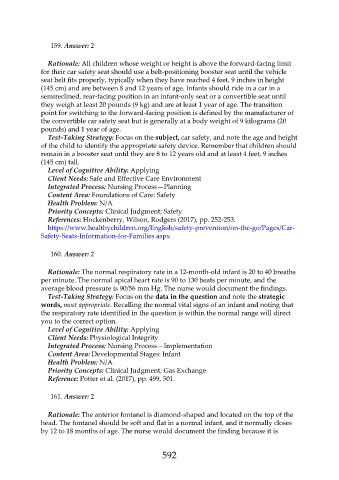Page 592 - Saunders Comprehensive Review For NCLEX-RN
P. 592
159. Answer: 2
Rationale: All children whose weight or height is above the forward-facing limit
for their car safety seat should use a belt-positioning booster seat until the vehicle
seat belt fits properly, typically when they have reached 4 feet, 9 inches in height
(145 cm) and are between 8 and 12 years of age. Infants should ride in a car in a
semireclined, rear-facing position in an infant-only seat or a convertible seat until
they weigh at least 20 pounds (9 kg) and are at least 1 year of age. The transition
point for switching to the forward-facing position is defined by the manufacturer of
the convertible car safety seat but is generally at a body weight of 9 kilograms (20
pounds) and 1 year of age.
Test-Taking Strategy: Focus on the subject, car safety, and note the age and height
of the child to identify the appropriate safety device. Remember that children should
remain in a booster seat until they are 8 to 12 years old and at least 4 feet, 9 inches
(145 cm) tall.
Level of Cognitive Ability: Applying
Client Needs: Safe and Effective Care Environment
Integrated Process: Nursing Process—Planning
Content Area: Foundations of Care: Safety
Health Problem: N/A
Priority Concepts: Clinical Judgment; Safety
References: Hockenberry, Wilson, Rodgers (2017), pp. 252-253.
https://www.healthychildren.org/English/safety-prevention/on-the-go/Pages/Car-
Safety-Seats-Information-for-Families.aspx
160. Answer: 2
Rationale: The normal respiratory rate in a 12-month-old infant is 20 to 40 breaths
per minute. The normal apical heart rate is 90 to 130 beats per minute, and the
average blood pressure is 90/56 mm Hg. The nurse would document the findings.
Test-Taking Strategy: Focus on the data in the question and note the strategic
words, most appropriate. Recalling the normal vital signs of an infant and noting that
the respiratory rate identified in the question is within the normal range will direct
you to the correct option.
Level of Cognitive Ability: Applying
Client Needs: Physiological Integrity
Integrated Process: Nursing Process—Implementation
Content Area: Developmental Stages: Infant
Health Problem: N/A
Priority Concepts: Clinical Judgment; Gas Exchange
Reference: Potter et al. (2017), pp. 499, 501.
161. Answer: 2
Rationale: The anterior fontanel is diamond-shaped and located on the top of the
head. The fontanel should be soft and flat in a normal infant, and it normally closes
by 12 to 18 months of age. The nurse would document the finding because it is
592

